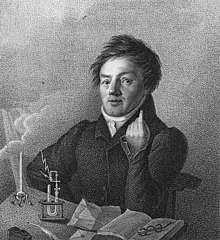Döbereiner's triads
In the history of the periodic table, Döbereiner's triads were an early attempt to sort the elements into some logical order by their physical properties. In 1817, a letter reported Johann Wolfgang Döbereiner's observations of the alkaline earths; namely, that strontium had properties that were intermediate to those of calcium and barium.[1] By 1829, Döbereiner had found other groups of three elements (hence "triads") whose physical properties were similarly related.[2] He also noted that some quantifiable properties of elements (e.g. atomic weight and density) in a triad followed a trend whereby the value of the middle element in the triad would be exactly or nearly predicted by taking the arithmetic mean of values for that property of the other two elements.
| Triad name[2] | Elements and atomic masses[2][3] | ||
|---|---|---|---|
| Element 1 Mass |
Element 2 Mean of 1 and 3 Actual mass |
Element 3 Mass | |
| Alkali-forming elements | Lithium 6.94 |
Sodium 23.02 22.99 |
Potassium 39.10 |
| Alkaline-earth-forming elements |
Calcium 40.1 |
Strontium 88.7 87.6 |
Barium 137.3 |
| Salt-forming elements | Chlorine 35.470 |
Bromine 80.470 78.383 |
Iodine 126.470 |
| Acid-forming elements | Sulfur 32.239 |
Selenium 80.741 79.263 |
Tellurium 129.243 |
| - |
Iron 55.8 |
Cobalt 57.3 58.9 |
Nickel 58.7 |

References
- Wurzer, Ferdinand (1817). "Auszug eines Briefes vom Hofrath Wurzer, Prof. der Chemie zu Marburg" [Excerpt of a letter from Court Advisor Wurzer, Professor of Chemistry at Marburg]. Annalen der Physik (in German). 56 (7): 331–334. Bibcode:1817AnP....56..331.. doi:10.1002/andp.18170560709. From pp. 332–333: "In der Gegend von Jena (bei Dornburg) … Schwerspaths seyn möchte." (In the area of Jena (near Dornburg) it is known that celestine has been discovered in large quantities. This gave Mr. Döbereiner cause to inquire rigorously into the stoichiometric value of strontium oxide by a great series of experiments. It turned out that it [i.e., the molar weight of strontium oxide] – if that of hydrogen is expressed by 1 or that of oxygen is expressed by the number 7.5 – is equal to 50. This number is, however, precisely the arithmetic mean of that which denotes the stoichiometric value of calcium oxide (= 27.55) and of that which denotes the stoichiometric value of barium oxide (= 72.5) ; namely (27.5 + 72.5) / 2 = 50. For a moment, Mr. Döbereiner found himself thereby caused to doubt the independent existence of strontium; however, this withstood both his analytical and synthetic experiments. Even more noteworthy is the circumstance that the specific weight of strontium sulfide is likewise the arithmetic mean of that of pure (water-free) calcium sulfide and that [i.e., the sulfide] of barium, namely (2.9 + 4.40) / 2 = 3.65 ; which must cause [one] to believe even more that celestine might be a mixture of equal stoichiometric amounts of anhydrite [i.e., anhydrous calcium sulfate] and barite.)
- Döbereiner, J. W. (1829). "Versuch zu einer Gruppirung der elementaren Stoffe nach ihrer Analogie" [An attempt to group elementary substances according to their analogies]. Annalen der Physik und Chemie. 2nd series (in German). 15 (2): 301–307. Bibcode:1829AnP....91..301D. doi:10.1002/andp.18290910217. For an English translation of this article, see: Johann Wolfgang Döbereiner: "An Attempt to Group Elementary Substances according to Their Analogies" (Lemoyne College (Syracuse, New York, USA))
- "Johann Wolfgang Dobereiner". Archived from the original on 2016-03-23. Retrieved 2016-03-23.
- "A Historic Overview: Mendeleev and the Periodic Table" (PDF). Retrieved 2013-01-15.